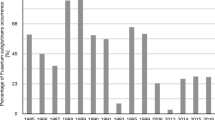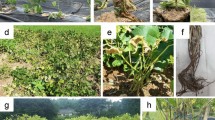Abstract
In a recent study, a population of Fusarium strains isolated from maize in Belgium was described as a new species, F. temperatum, that is morphologically similar and phylogenetically closely related to F. subglutinans, a species in the American clade of the Gibberella fujikuroi species complex. In fields, the F. temperatum:F. subglutinans ratio was very high, suggesting that F. temperatum outcompetes its sister species F. subglutinans. This raised the question whether this novel species contributes to the final rot symptoms observed on maize plants at harvest, as well as to the potential mycotoxin contamination. Results of the pathogenicity tests by soil and toothpick inoculation demonstrate the ability of F. temperatum to cause seedling malformation and stalk rot under greenhouse conditions. Screening of 15 Fusarium mycotoxins showed the ability of F. temperatum to produce moniliformin, beauvericin, enniatins and fumonisin B1. The results indicate that F. temperatum can produce mycotoxins and cause maize diseases and, therefore, poses a potential risk to maize production and to the safety of human food and animal feed.

Similar content being viewed by others
References
Ares, J. L. A., Ferro, R. C. A., Ramirez, L. C., & Gonzales, J. M. (2004). Fusarium graminearum Schwabe, a maize root and stalk rot pathogen isolated from lodged plants in northwest Spain. Spanish Journal of Agricultural Research, 2, 249–252.
Bottalico, A. (1998). Fusarium diseases of cereals: species complex and related mycotoxin profiles, in Europe. Journal of Plant Pathology, 80, 85–103.
Britz, H., Coutinho, T. A., Wingfield, M. J., Marasas, W. F. O., Gordon, T. R., & Leslie, J. F. (1999). Fusarium subglutinans f. sp. pini represents a distinct mating population in the Giberrella fujikuroi species complex. Applied and Environmental Microbiology, 65, 1198–1201.
Danielsen, S., Meyer, U. M., & Funck Jensen, D. (1998). Genetic characteristics of Fusarium verticillioides isolates from maize in Costa Rica. Plant Pathology, 47, 615–622.
Desjardins, A. E. (2006). Fusarium mycotoxins: chemistry, genetics and biology. Saint Paul: APS.
Desjardins, A. E., Maragos, C. M., & Proctor, R. H. (2006). Maize ear rot and moniliformin contamination by cryptic species of Fusarium subglutinans. Journal of Agricultural and Food Chemistry, 54, 7383–7390.
Desjardins, A. E., Plattner, R. D., Nelsen, T. C., & Leslie, J. F. (1995). Genetic analysis of fumonisin production and virulence of Gibberella fujikuroi mating population A (Fusarium moniliforme) on maize (Zea mays) seedlings. Applied and Environmental Microbiology, 61, 79–86.
Dorn, B., Forrer, H. R., Schürch, S., & Vogelgsang, S. (2009). Fusarium species complex on maize in Switzerland: occurrence, prevalence, impact and mycotoxins in commercial hybrids under natural infection. European Journal of Plant Pathology, 125, 51–61.
Fotso, J., Leslie, J. F., & Smith, J. S. (2002). Production of beauvericin, moniliformin, fusaproliferin, and fumonisins B1, B2 and B3 by ex-type strains of fifteen Fusarium species. Applied and Environmental Microbiology, 68, 5195–5197.
Goertz, A., Zühlke, S., Spiteller, M., Steiner, U., Dehne, H. W., Waalwijk, C., de Vries, P. M., & Oerke, E. C. (2010). Fusarium species and mycotoxin profiles on commercial maize hybrids in Germany. European Journal of Plant Pathology, 128, 101–111.
Jestoi, M. (2008). Emerging Fusarium-mycotoxins fusaproliferin, beauvericin, enniatins, and moniliformin – a review. Critical Reviews in Food Science and Nutrition, 48, 21–49.
Kvas, M., Marasas, W. F. O., Wingfield, B. D., Wingfield, M. J., & Steenkamp, E. T. (2009). Diversity and evolution of Fusarium species in the Gibberella fujikuroi complex. Fungal Diversity, 34, 1–21.
Leslie, J. F., & Summerell, B. A. (2006). The Fusarium laboratory manual. Ames: Blackwell.
Leslie, J. F., Zeller, K. A., Logrieco, A., Mulè, G., Moretti, A., & Ritieni, A. (2004). Species diversity of and toxin production by Gibberella fujikuroi species complex strains isolated from native prairie grasses in Kansas. Applied and Environmental Microbiology, 70, 2254–2262.
Lew, H., Adler, A., & Edinger, W. (1997). Dynamics of the Fusarium toxin distribution in maize plants affected by stalk rot. Cereal Research Communications, 25, 467–470.
Logrieco, A., Moretti, A., Castella, G., Kostecki, M., Golinski, P., Ritieni, A., & Chelkowski, J. (1998). Beauvericin production by Fusarium species. Applied and Environmental Microbiology, 64, 3084–3088.
Logrieco, A., Mulè, G., Moretti, A., & Bottalico, A. (2002). Toxigenic Fusarium species and mycotoxins associated with maize ear rot in Europe. European Journal of Plant Pathology, 108, 597–609.
Maiorano, A., Blandino, M., Reyneri, A., & Vanara, F. (2008). Effects of maize residues on the Fusarium spp. infection and deoxynivalenol (DON) contamination of wheat grain. Crop Protection, 27, 182–188.
Marasas, W. F. O., Nelson, P. E., & Toussoun, T. A. (1984). Toxigenic Fusarium species: identity and mycotoxicology. University Park: Pennsylvania State University Press.
Moretti, A., Logrieco, A., Bottalico, A., Ritieni, A., Randazzo, G., & Corda, P. (1995). Beauvericin production by Fusarium subglutinans from different geographical areas. Mycological Research, 99, 282–286.
Moretti, A., Mulé, G., Ritieni, A., Láday, M., Stubnya, V., Hornok, L., & Logrieco, A. (2008). Cryptic subspecies and beauvericin production by Fusarium subglutinans from Europe. International Journal of Food Microbiology, 127, 312–315.
Moretti, A., Mule, G., Ritieni, A., & Logrieco, A. (2007). Further data on the production of beauvericin, enniatins and fusaproliferin and toxicity to Artemia salina by Fusarium species of Gibberella fujikuroi species complex. International Journal of Food Microbiology, 118, 158–163.
Munkvold, G. P. (2003). Epidemiology of Fusarium diseases and their mycotoxins in maize ears. European Journal of Plant Pathology, 109, 705–713.
Nelson, P. E., Plattner, R. D., Shackelford, D. D., & Desjardins, A. E. (1992). Fumonisin B1 production by Fusarium species other than F. moniliforme in section Liseola and by some related species. Applied and Environmental Microbiology, 58, 984–989.
Nelson, P. E., Toussoun, T. A., & Marasas, W. F. O. (1983). Fusarium species: an illustrated manual for identification. University Park: Pennsylvania State University Press.
Nirenberg, H. I., & O’Donnell, K. (1998). New Fusarium species and combinations within the Gibberella fujikuroi species complex. Mycologia, 90, 434–458.
O’Donnell, K., Nirenberg, H. I., Aoki, T., & Cigelnik, E. (2000). A multigene phylogeny of the Gibberella fujikuroi species complex: detection of additional phylogenetically distinct species. Mycoscience, 41, 61–78.
Picot, A., Hourcade-Marcolla, D., Barreau, C., Pinson-Gadais, L., Caron, D., Richard-Forget, F., & Lannou, C. (2011). Interactions between Fusarium verticillioides and Fusarium graminearum in maize ears and consequences for fungal development and mycotoxin accumulation. Plant Pathology. doi:10.1111/j.1365-3059.2011.02503.x.
Proctor, R. H., Plattner, R. D., Brown, D. W., Seo, J., & Lee, Y. (2004). Discontinuous distribution of fumonisin biosynthetic genes in the Gibberella fujikuroi species complex. Mycological Research, 108, 815–822.
Rheeder, J. P., Marasas, W. F. O., & Vismer, H. F. (2002). Production of fumonisin analogs by Fusarium species. Applied and Environmental Microbiology, 68, 2101–2105.
Scauflaire, J., Gourgue, M., & Munaut, F. (2011a). Fusarium temperatum sp. nov. from maize, an emergent species closely related to Fusarium subglutinans. Mycologia, 103, 586–597.
Scauflaire, J., Mahieu, O., Louvieaux, J., Foucart, G., Renard, F., & Munaut, F. (2011b). Biodiversity of Fusarium species in ears and stalks of maize plants in Belgium. European Journal of Plant Pathology, 131, 59–66.
Shephard, G. S., Sewram, V., Nieuwoudt, T. W., Marasas, W. F. O., & Ritieni, A. (1999). Production of the mycotoxins fusaproliferin and beauvericin by South African isolates in the Fusarium section Liseola. Journal of Agricultural and Food Chemistry, 47, 5111–5115.
Steenkamp, E. T., Wingfield, B. D., Coutinho, T. A., Wingfield, M. J., & Marasas, W. F. O. (1999). Differentiation of Fusarium subglutinans f. sp. pini by histone gene sequence data. Applied and Environmental Microbiology, 65, 3401–3406.
Steenkamp, E. T., Wingfield, B. D., Desjardins, A. E., Marasas, W. F. O., & Wingfield, M. J. (2002). Cryptic speciation in Fusarium subglutinans. Mycologia, 94, 1032–1043.
Stępień, L., Koczyk, G., & Waśkiewicz, A. (2011). FUM cluster divergence in fumonisins-producing Fusarium species. Fungal Biology, 115, 112–123.
Zeller, K. A., Summerell, B. A., Bullock, S., & Leslie, J. F. (2003). Gibberella konza (Fusarium konzum) sp. nov. from prairie grasses, a new species in the Gibberella fiujikuroi species complex. Mycologia, 95, 943–954.
Acknowledgments
This research was funded by the Direction Générale de l’Agriculture, Direction de la Recherche, ref. 1217, in the framework of the project Caractérisation et dynamique des fusarioses sur maïs en Région Wallonne. We thank the FYMY for providing the greenhouses for the research and for technical assistance. F. Munaut is funded by the Mycothèque de l’Université catholique de Louvain (BCCMTM /MUCL).
Author information
Authors and Affiliations
Corresponding author
Rights and permissions
About this article
Cite this article
Scauflaire, J., Gourgue, M., Callebaut, A. et al. Fusarium temperatum, a mycotoxin-producing pathogen of maize. Eur J Plant Pathol 133, 911–922 (2012). https://doi.org/10.1007/s10658-012-9958-8
Accepted:
Published:
Issue Date:
DOI: https://doi.org/10.1007/s10658-012-9958-8




